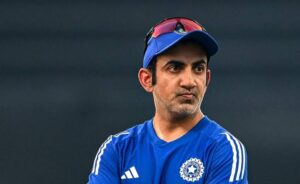
By Ashok Namboodiri at Eden Gardens
Is it time to think of a split coaching role and philosophy for the Indian team in white-ball versus red-ball cricket?
India’s 30-run defeat to South Africa at Eden Gardens will be remembered less for the margin and more for what it symbolises: a collapse chasing 124 on a turning home track, a furious debate over pitches, and a head coach whose red-ball report card now looks nothing like his white-ball resume. At the centre of it all is Gautam Gambhir.
On paper, Gambhir’s white-ball tenure is exactly what the BCCI hoped for when it turned to a World Cup-winning opener and IPL-winning captain. The 2025 Champions Trophy and the Asia Cup in the bag, an approximate 90% win rate in T20s, above 70% in ODIs, and the emergence of India as a formidable white-ball outfit capable of winning major tournaments.
The Test story is the mirror opposite. A 3–0 home whitewash to New Zealand in late 2024, ending India’s 18-series unbeaten run at home. A lost Border–Gavaskar Trophy in Australia, 3–1, where India were outplayed in seamer-friendly conditions and finished the series well behind. A gripping but ultimately drawn away series against England (2–2), not the statement win Indian fans have come to expect. A much-needed 2–0 win over the West Indies at home that looked, at the time, like the start of a reset. Add Kolkata to that and the report card looks bleak.
India have now lost four of their last six home Tests, a staggering drop for a side that had lost only two home Tests between 2015 and 2022. Gambhir insisted there were “no demons” in the pitch, calling it “exactly the wicket we wanted,” and framed the defeat as a question of temperament rather than conditions. In isolation, that’s classic old-school tough love. In context, it raises serious, structural questions about his red-ball strategy.
Gambhir’s white-ball India is built on a high-intent, short-burst model: attack early, accept volatility, back depth. In Tests, that can morph into a side that takes high-risk options on both selection and surfaces, ultra-aggressive pitches, short batting line-ups, without yet having the batting maturity to survive when the ball wins. Eden, like Wankhede against New Zealand before it, felt like India creating conditions they themselves couldn’t handle over four innings.
So what happens next? Do we see this as a pattern of strategic overreach in conditions and approach? Is there a clear, consistent red-ball selection philosophy? Is there a case to bifurcate white-ball coaching from red-ball coaching? Do we acknowledge that in an era of three formats, one man’s template need not be stretched across all of them?
Are there precedents? Pakistan split the role in 2024, appointing Jason Gillespie as red-ball head coach and Gary Kirsten as white-ball head coach for the men’s team, explicitly recognising the different demands of Tests versus ODIs/T20Is. England previously used split coaching roles, with Matthew Mott handling white-ball and Brendon McCullum in charge of Tests, before later asking McCullum to combine responsibilities. The principle is the same: separate what is working brilliantly from what isn’t instead of blowing up the entire system. What would be unprecedented for India is not the split itself, but the willingness to admit that a national head coach can be world-class in one format and a work-in-progress in another, and to act on that distinction.
Follow Revsportz for latest sports news





